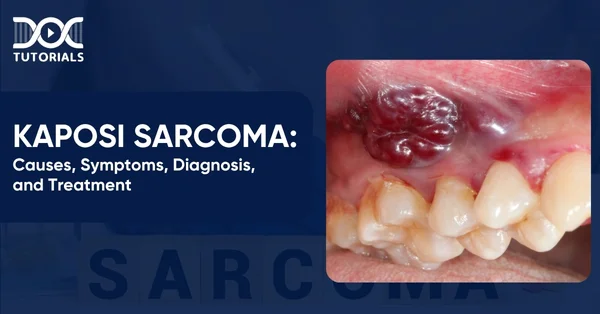Kaposi Sarcoma: Causes, Symptoms, Diagnosis, and Treatment

Kaposi sarcoma is a cancer that affects the skin and mucous membranes, including those of the gastrointestinal tract. It is characterised by the appearance of purple patches or nodular growths on the skin or mucosal surfaces, which may spread to the lymph nodes or lungs in more advanced cases.
It has been widely associated with immune suppression, and it must be diagnosed early enough and given proper care to manage the condition. For NEET PG aspirants, understanding its causes, clinical features, and management is important.
Read on to learn more.
What is Kaposi Sarcoma?
Kaposi sarcoma (KS) is a rare form of cancer that develops in the cells lining the blood vessels and lymphatic vessels. It is characterised by the growth of abnormal tissue, which can result in tumours appearing on the skin or within other parts of the body.
These tumours come in the form of patches or lesions, normally purple, red or brown, that are mostly found on the face, legs, mouth, nose, eyes or around the anus. While these skin lesions are often painless and may not produce any immediate symptoms, the condition can become more serious if it spreads internally.
Organs that KS may target include the lungs, liver, stomach, intestines or lymph nodes. In such scenarios, it can result in complications such as the inability to breathe or internal bleeding, which involves the digestive system or the respiratory tract.
What are the Types of Kaposi Sarcoma?
Kaposi sarcoma exists in various forms, which are determined by the cause of the illness and the population of victims:
- Epidemic or AIDS-related Kaposi Sarcoma
This form is commonly seen in individuals living with human immunodeficiency virus (HIV), the virus responsible for acquired immunodeficiency syndrome (AIDS). It is regarded as one of the AIDS-defining illnesses that tends to be more aggressive due to weakened immune function.
- Iatrogenic or Transplant-associated Kaposi Sarcoma
This type arises in individuals who are receiving immunosuppressive therapy following organ transplantation. The suppressed immune response increases susceptibility to KS, particularly in those already carrying the human herpesvirus 8 (HHV-8), which is linked to the disease.
- Endemic Kaposi Sarcoma
Found predominantly among children and young adults in certain regions of Africa, this variant can manifest either as slow-growing skin lesions or as a more rapidly progressing disease affecting internal organs.
- Classic Kaposi Sarcoma
Usually affecting older adults of Eastern European, Mediterranean, or Middle Eastern origin, this form of KS progresses slowly. It is often characterised by lesions that may lead to swelling, particularly in the lower limbs.
What are the Causes of Kaposi Sarcoma?
KS is linked to infection with human herpesvirus 8 (HHV-8), also referred to as Kaposi sarcoma-associated herpesvirus (KSHV). Although this virus is a key factor in the development of Kaposi sarcoma, its presence alone does not guarantee that the condition will develop. Nevertheless, there are other contributing factors as well that can develop this cancer.
What are the Risk Factors of Kaposi Sarcoma?
Several factors increase the risk of developing Kaposi sarcoma, such as:
- Age
The disease is mostly detected in the age group of 40-70 years.
- Sex
Males have been found to develop KS more frequently than females.
- Ethnic Background
A higher incidence is observed among those of Mediterranean, Eastern European, Southwest Asian, or Ashkenazi Jewish heritage. In addition, individuals who reside in certain parts of Africa are at increased risk for endemic forms of the disease.
- Weakened Immune System
Kaposi sarcoma is more likely to develop in individuals with compromised immune function. This may result from immunosuppressive treatment following organ transplantation or from conditions such as HIV/AIDS (human immunodeficiency virus infection and acquired immune deficiency syndrome)
- Unprotected Sexual Activity
Since both human herpesvirus 8 (HHV-8) and HIV are primarily transmitted through bodily fluids, engaging in unprotected sex can elevate the risk of infection and subsequent development of the disease.
What are the Symptoms of Kaposi Sarcoma?
Kaposi’s sarcoma symptoms are as follows:
- Skin Lesions
The earliest signs usually include cancerous spots on the skin that are purple, red or brown in colour. These may be flat or raised and can appear in isolated areas or be widespread. Legs, feet and face are the commonly affected regions. In some cases, these lesions may become disfiguring.
- Mucosal Involvement
Lesions may also develop on mucous membranes, such as those found in the mouth, anus or various parts of the gastrointestinal tract.
- Internal Lesions
When lesions appear within the lungs, they can lead to restricted breathing or episodes of coughing up blood. Lesions in the gastrointestinal tract can result in abdominal pain and internal bleeding, which may contribute to the development of anaemia over time.
- Lymph Node Involvement
The lymph nodes, particularly those in the groin, may be affected. It leads to painful swelling of the legs due to impaired lymphatic drainage.
How to Diagnose Kaposi Sarcoma?
A healthcare professional performs the following tests to accurately diagnose Kaposi sarcoma:
- Immunohistochemistry
This laboratory technique is used to detect a particular protein known as LANA-1 (latency-associated nuclear antigen 1), which is linked to Human Herpesvirus 8 (HHV-8). The presence of LANA-1 assists medical professionals in distinguishing Kaposi sarcoma from other lesions that may appear similar under the microscope.
- Chest X-ray
As the disease frequently spreads to the lungs, most individuals undergo a chest X-ray. This imaging test is often performed even in the absence of respiratory symptoms, in order to detect any hidden involvement of the lungs.
- Bronchoscopy
When there are abnormalities in the lungs or if there are respiratory symptoms such as haemoptysis (coughing up blood) or difficulty breathing, a bronchoscopy is recommended. This procedure allows for direct visualisation of the trachea and bronchial passages using a thin, flexible tube with a camera.
- Skin Biopsy
Direct diagnosis usually includes a biopsy in which small tissue samples are taken from suspected lesions. Pathologists examine such samples with a microscope to analyse whether these samples contain cancerous Kaposi sarcoma cells.
- Endoscopy
In cases where there is gastrointestinal bleeding, persistent abdominal discomfort, or unexplained anaemia, further investigation with upper endoscopy or colonoscopy may be necessary. These procedures help to detect internal lesions in the digestive tract that are not visible externally.
What are the Treatment Options for Kaposi Sarcoma?
Treatment of Kaposi sarcoma is based on how extensive the disease is, its location and the health condition of the whole body. Various approaches may be employed either individually or in combination to achieve the best outcomes.
- Antiretroviral Therapy (ART)
ART suppresses the multiplication of the human immunodeficiency virus (HIV), thereby making the immune system able to resist human herpesvirus 8 (HHV-8), which is a major contributing factor to the progression of KS.
Effective use of ART can significantly slow disease progression and may lead to partial or complete resolution of the lesions.
- Localised Treatments
Localised treatments are used where the illness is restricted to small regions, so that individual lesions can be dealt with. Options include:
- Topical Medications: This includes the use of specially prescribed creams or ointments being applied to the affected areas.
- Intralesional Therapy: Injecting drugs like chemotherapy agents or immune-modulating substances straight into the lesions.
- Cryotherapy: Use of liquid nitrogen for freezing and destroying abnormal tissue.
- Laser Therapy: High-powered laser rays are used to burn off lesions.
- Surgical Excision: In certain cases, individual lesions may be removed through minor surgical procedures.
- Photodynamic Therapy (PDT): A photosensitising drug is applied to the skin and absorbed by tumour cells over time. The treated area is then exposed to a specific light source that activates the drug and selectively destroys the cancerous cells.
- Systemic Therapy
Systemic treatment is usually necessary when Kaposi sarcoma becomes common. This can be through chemotherapy or immunotherapy, and this is done in the whole body to attack the cancer cells wherever they are found.
- Radiation Therapy
External beam radiation therapy is usually recommended in the light of surface-level or visible KS lesions. Electron-beam radiation, in particular, is preferred due to its ability to penetrate only to shallow depths, thereby reducing side effects while effectively treating the affected areas.
FAQs About Kaposi Sarcoma
- Is Kaposi sarcoma classified as an autoimmune condition?
No, Kaposi sarcoma is not classified as an autoimmune condition. It is a cancer connected with HHV-8 (human herpesvirus 8) infection and does not result from the immune system attacking the body’s own tissues.
- How is Kaposi sarcoma diagnosed?
KS diagnosis involves physical examination, skin biopsy, imaging tests like chest X-rays, and procedures such as bronchoscopy, endoscopy, and immunohistochemistry.
- What treatment options are available for Kaposi sarcoma?
Treatment may include antiretroviral therapy (ART), localised therapies, systemic chemotherapy or immunotherapy, and radiation therapy, depending on disease severity.
Conclusion
A clear knowledge of Kaposi sarcoma along with its causes, symptoms, diagnostic tools and treatment options is essential not just for clinical practice but also for NEET PG exam success. Recognising the condition early and managing it effectively can make a real difference, especially in patients with weakened immunity.
This topic is crucial for NEET PG aspirants who want to enhance their diagnostic reasoning and clinical knowledge. DocTutorials offers structured NEET PG preparation through focused video lectures, concise notes and integrated learning sessions to help students succeed.
Latest Blogs
-

INI CET Exam 2025: Your Roadmap to Success – Key Topics, Strategies, and Lessons from Last Year’s Papers
The INI CET exam is more than just a test; it’s a significant milestone for many medical students aiming to…
-

INI CET Exam Success: Previous Year Question Papers & Ultimate Guide – INI CET PYQ
One can feel overwhelmed while preparing for the INI CET (Institute of National Importance Combined Entrance Test). A vast syllabus,…
-

INI CET Exam Pattern 2024: A Complete Guide with Subject-Wise Weightage
The Institute of National Importance Combined Entrance Test (INI CET) is your key to entering some of the most prestigious…




